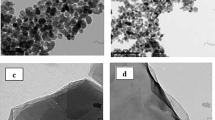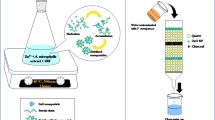Abstract
The present work aimed to remove azithromycin (AZM) from the contaminated aqueous system using a water/ethanol/transcutol/Capryol-90 green nanoemulsion. The drug is identified as a potential pharmaceutical contaminant detrimental for flora and fauna of aquatic lives as well as human health. Green nanoemulsions were tailored and characterized for thermodynamic stability, size, polydispersity index (PDI), zeta potential, viscosity, refractive index (RI), and morphological assessment using a transmission electron microscopy (TEM). Moreover, nanoemulsions were investigated for percent removal efficiency (%RE) and factors affecting percent removal efficiency (%RE). The results suggested that the developed green nanoemulsions (ANE1–ANE5) were transparent (˂ 200 nm) and stable. ANE5 exhibited the lowest value of globular size (49 nm), PDI (0.17), viscosity (~ 93 cP), and optimum zeta potential (−27.8 mV). The value of %RE depended upon the content of water and Capryol-90 of the nanoemulsion. Furthermore, the value of %RE was found to be increased with increased content of water, whereas this was decreased on increasing the Capryol-90 content in the nanoemulsions. Similarly, on decreasing the values of size and viscosity, the %RE values were observed to be increased. There was insignificant impact of the duration of exposure time on %RE. Thus, the maximum %RE value (96.8%) was obtained by ANE5 from the aqueous solution after 20 min of contact time with ANE5. Thus, this method could be a promising approach to remove AZM from the contaminated water and serve as an alternative to conventional methods.
Graphical abstract








Similar content being viewed by others
References
Ali MS, Alam MS, Alam N, Siddiqui MR (2014) Preparation, characterization and stability study of dutasteride loaded nanoemulsion for treatment of benign prostatic hypertrophy. Iranian J Pharmac Res 13(4):1125–1140
Alliod O, Messager L, Fessi H, Dupin D, Charcosset C (2019) Influence of viscosity for oil-in-water and water-in-oil nanoemulsions production by SPG premix membrane emulsification. Chemical Engineering Research and Design, Elsevier 142:87–99
Assi RA, Abdulbaqi IM, Ming TS, Yee CS, Wahab HA, Asif SM, Darwis Y (2020) Liquid and solid self-emulsifying drug delivery systems (SEDDs) as carriers for the oral delivery of azithromycin: optimization, in vitro characterization and stability assessment. Pharmaceutics 12(11):1052
Ávila C, García-Galán MJ, Borrego CM, Rodríguez-Mozaz S, García J, Barceló D (2021) New insights on the combined removal of antibiotics and ARGs in urban wastewater through the use of two configurations of vertical subsurface flow constructed wetlands. Sci Total Environ 755:142554
Davoodi S, Dahrazma B, Goudarzi N, Gorji HG (2019) Adsorptive removal of azithromycin from aqueous solutions using raw and saponin-modified nano diatomite. Water Sci Technol 80(5):939–949
Decision 2015/495/EU (2015) Commission implementing decision (EU) 2015/495 of 20 March 2015 establishing a watch list of substances for Union-wide monitoring in the field of water policy pursuant to Directive 2008/105/EC of the European Parliament and of the Council. Off J Eur Union L78:40–42
Fent K, Weston AA, Caminada D (2006) Ecotoxicology of human pharmaceuticals. Aquat Toxicol 76(2):122–159
Ghosh GC, Hanamoto S, Yamashita N, Huang X, Tanaka H (2016) Antibiotics removal in biological sewage treatment plants. Pollution 2(2):131–139
Hussain A, Singh SK, Singh N, Verma PRP (2016) In vitro–in vivo–in silico simulation studies of anti-tubercular drugs doped with a self-nanoemulsifying drug delivery system. RSC Adv 6(95):93147–93161
Hussain A, Mahdi WA, Alshehri S, Bukhari SI, Almaniea MA (2021) Application of green nanoemulsion for elimination of rifampicin from a bulk aqueous solution. Int J Environ Res Public Health 18:5835
Kauss T, Gaubert A, Boyer C, Ba BB, Manse M, Massip S, Jean-Michel L, Fawaz F, Lembege M, Jean-Michel B, Lafarge X, Lindegardh N, White NJ, Olliaro P, Millet P, Gaudin K (2013) Pharmaceutical development and optimization of azithromycin suppository for paediatric use. Int J Pharm 441(1-2):218–226
Khalil AME, Memon FA, Tabish TA, Fenton B, Salmon D, Zhang S, Butler D (2021) Performance evaluation of porous graphene as filter media for the removal of pharmaceutical/emerging contaminants from water and wastewater. Nanomaterials 11:79
Luo X, Hao T, Yue L, Hong G, Lu Y (2016) Azithromycin wastewater treatment with La doping titanium dioxide /active carbon composites. 4th International Conference on Sensors, Measurement and Intelligent Materials (ICSMIM 2015): 861-870.
Luo Z, Yu G, Han X, Yang T, Ji Y, Huang H, Wang G, Liu Y, Sun W (2020) Prediction of the pharmacokinetics and pharmacodynamics of topiroxostat in humans by integrating the physiologically based pharmacokinetic model with the drug-target residence time model. Biomed Pharmacother 121:109660
Mackuľak T, Nagyová K, Faberová M, Grabic R, Koba O, Gál M, Birošová L (2015) Utilization of Fenton-like reaction for antibiotics and resistant bacteria elimination in different parts of WWTP. Environ Toxicol Pharmacol 40(2):492–497
Mahdi WA, Hussain A, Bukhari SI, Alshehri S, Singh B, Ali N (2021) Removal of clarithromycin from aqueous solution using water/triton X-100/ ethanol/ olive oil green nanoemulsion method. Journal of Water Process Engineering 40:101973
Muñoz-Calderón A, Zúñiga-Benítez H, Valencia SH, Rubio-Clemente A, Upegui SA, Peñuela GA (2020) Use of low frequency ultrasound for water treatment: data on azithromycin removal. Data in Brief 31:105947
Mutak S (2007) Azalides from azithromycin to new azalide derivatives. J Antibiotics 60(2):85–122
Ngan CL, Basri M, Tripathy M, Karjiban AR, Abdul-Malek E (2014) Physicochemical characterization and thermodynamic studies of nanoemulsion-based transdermal delivery system for fullerene. Sci World J:1–12
Osorio V, Larrañaga A, Aceña J, Pérez S, Barceló D (2016) Concentration and risk of pharmaceuticals in freshwater systems are related to the population density and the livestock units in Iberian Rivers. Sci Total Environ 540:267–277
Pal R (2016) Modeling the viscosity of concentrated nanoemulsions and nanosuspensions. Fluids 1(2):11
Segura PA, Francois M, Gagnon C, Sauve S (2009) Review of the occurrence of anti-infectives in contaminated wastewaters and natural and drinking waters. Environ Health Perspect 117(5):675–684
Shakeel F, Haq N, Al-Dhfyan A, Alanazi FK, Alsarra IA (2013) Chemoprevention of skin cancer using low HLB surfactant nanoemulsion of 5-fluorouracil: a preliminary study. Drug Delivery 22(4):573–580
Shakeel F, Haq N, Ahmed MA, Gambhir D, Alanazi FK, Alsarra IA (2014a) Removal of diclofenac sodium from aqueous solution using water/transcutol/ethylene glycol/Capryol-90 green nanoemulsions. J Mol Liq 199:102–107
Shakeel F, Haq N, Alanazi FK, Alsarra IA (2014b) Box-Behnken statistical design for removal of methylene blue from its aqueous solution using SDS self-microemulsifying systems. Ind Eng Chem Res 53(3):1179–1188
Shakeel F, Haq N, Sumague TS, Alanazi FK, Alsarra IA (2014c) Removal of indomethacin from aqueous solution using multicomponent green nanoemulsions. J Mol Liq 198:329–333
Shakeel F, Haq N, Alanazi FK, Alsarra IA (2015) Removal of glibenclamide from aqueous solution using water/PEG-400/ethanol/eucalyptus oil green nanoemulsions. J Mol Liq 203:120–124
Verlicchi P, Zambello E (2014) How efficient are constructed wetlands in removing pharmaceuticals from untreated and treated urban wastewaters? A review Sci Total Environ 470-471:1281–1306
Zhu X, Fryd MM, Huangz JR, Mason TG (2012) Optically probing nanoemulsion compositions. Phys Chem Chem Phys 14:2455–2461
Acknowledgements
Authors are thankful to Prince Sattam Bin Abdulaziz University for providing necessary resources to conduct this research.
Author information
Authors and Affiliations
Contributions
Obaid Afzal: conceptualization, drafting, and writing. Afzal Hussain: data curation. Abdulmalik S.A. Altamimi: software, data curation and formal review. Raisuddin Ali: software and analysis
Corresponding author
Ethics declarations
Ethical approval
The study does not involve any animal or animal-related experiments.
Consent to participate
All the authors agreed to participate in the present research.
Consent to publish
All the authors agreed to publish this research finding.
Conflict of interest
The authors report no competing interests.
Additional information
Responsible Editor: Santiago V. Luis
Publisher’s note
Springer Nature remains neutral with regard to jurisdictional claims in published maps and institutional affiliations.
Highlights of the study
1. Pharmaceuticals-contaminated wastewater challenged human health and aquatic lives
2. Azithromycin (AZM) is commonly used antibiotic and exposed in water as effluent
3. Nanoemulsion could be a promising approach to remove AZM
Supplementary Information
ESM 1
(DOCX 510 kb)
Rights and permissions
About this article
Cite this article
Hussain, A., Afzal, O., Altamimi, A.S. et al. Application of green nanoemulsion to treat contaminated water (bulk aqueous solution) with azithromycin. Environ Sci Pollut Res 28, 61696–61706 (2021). https://doi.org/10.1007/s11356-021-15031-w
Received:
Accepted:
Published:
Issue Date:
DOI: https://doi.org/10.1007/s11356-021-15031-w




